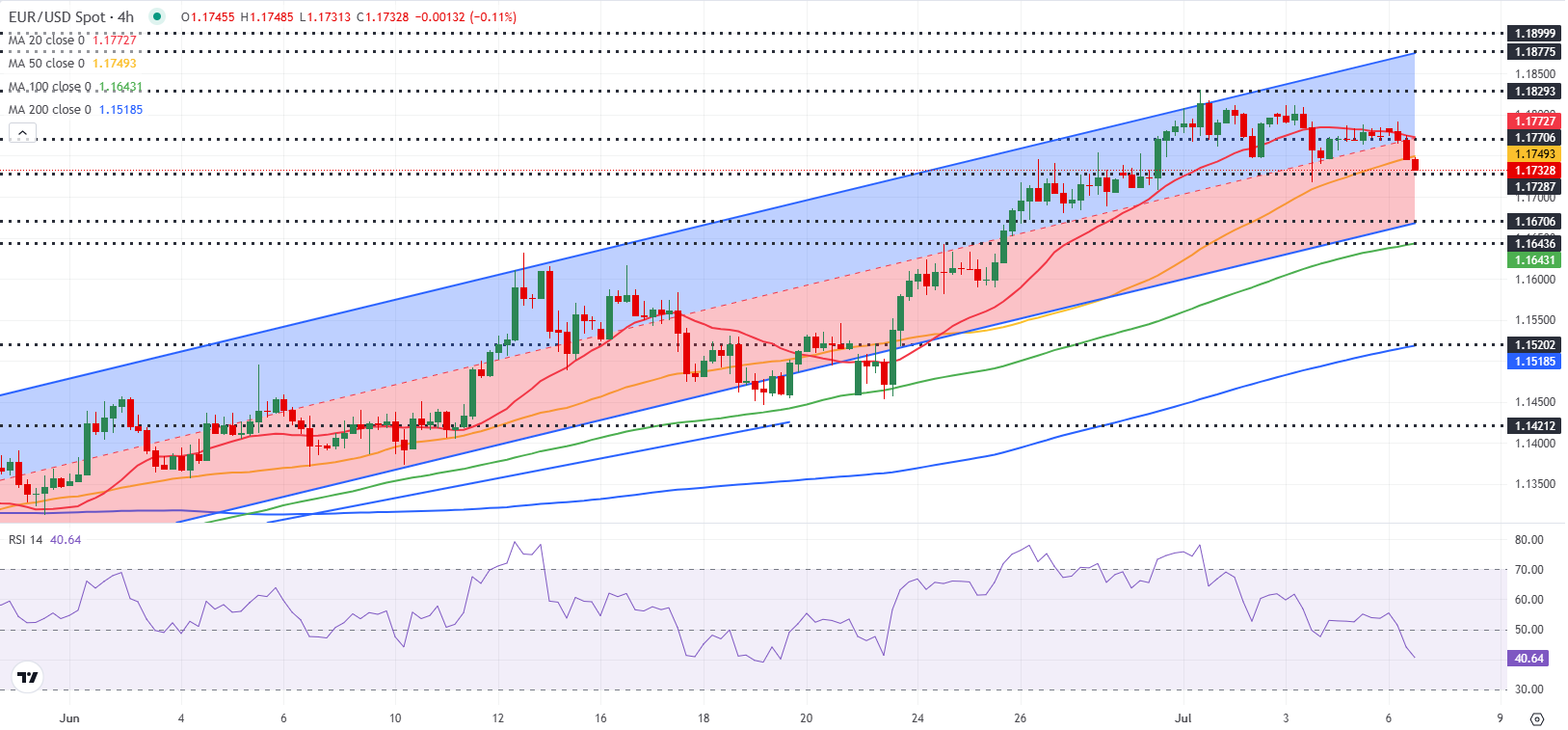
- EUR/USD trades in negative territory below 1.1750 on Monday.
- The risk-averse market atmosphere makes it difficult for the pair to gain traction.
- Markets await clarity on the EU-US trade relations.
EUR/USD stays under bearish pressure at the beginning of the week and trades below 1.1750. The pair’s technical outlook points to a bearish tilt in the near term as investors await news on the EU-US trade relations.
Euro PRICE Today
The table below shows the percentage change of Euro (EUR) against listed major currencies today. Euro was the weakest against the US Dollar.
| USD | EUR | GBP | JPY | CAD | AUD | NZD | CHF | |
|---|---|---|---|---|---|---|---|---|
| USD | 0.43% | 0.50% | 0.76% | 0.61% | 1.01% | 1.11% | 0.48% | |
| EUR | -0.43% | 0.08% | 0.07% | 0.15% | 0.65% | 0.67% | 0.03% | |
| GBP | -0.50% | -0.08% | -0.02% | 0.09% | 0.58% | 0.59% | -0.16% | |
| JPY | -0.76% | -0.07% | 0.02% | 0.09% | 0.48% | 0.57% | -0.21% | |
| CAD | -0.61% | -0.15% | -0.09% | -0.09% | 0.42% | 0.50% | -0.26% | |
| AUD | -1.01% | -0.65% | -0.58% | -0.48% | -0.42% | 0.11% | -0.73% | |
| NZD | -1.11% | -0.67% | -0.59% | -0.57% | -0.50% | -0.11% | -0.76% | |
| CHF | -0.48% | -0.03% | 0.16% | 0.21% | 0.26% | 0.73% | 0.76% |
The heat map shows percentage changes of major currencies against each other. The base currency is picked from the left column, while the quote currency is picked from the top row. For example, if you pick the Euro from the left column and move along the horizontal line to the US Dollar, the percentage change displayed in the box will represent EUR (base)/USD (quote).
The US Dollar (USD) benefits from the risk-averse market environment on Monday and weighs on EUR/USD. Reflecting the souring mood, US stock index futures were last seen losing between 0.2% and 0.6%.
Late Friday, a White House official said that trade negotiations with the EU were continuing and added that there was optimism an agreement could be reached soon. In the meantime, US President Donald Trump noted over the weekend that they will notify the countries, with which they fail to reach a deal, of tariff rates by July 9. Commerce Secretary Howard Lutnick explained that tariff rates will be set on by July 9 but they will take effect on August 1.
The data from Germany showed early Monday that Industrial Production grew by 1.2% on a monthly basis in May. This reading followed the 1.6% decrease recorded in April and came in better than the market expectation for a no change but failed to help the Euro gather strength.
In the absence of high-impact data releases, the risk perception could continue to drive EUR/USD’s action in the near term. In case Wall Street’s main indexes open on a bearish note and continue to push lower, the USD could hold its ground and continue to drag the pair lower. On the other hand, the pair could stage a rebound if markets turn optimistic about an EU-US trade deal ahead of the July 9 deadline.
EUR/USD Technical Analysis

EUR/USD dropped below the 20-period and the 50-period Simple Moving Averages (SMA) on the 4-hour chart and the Relative Strength Index declined to 40, highlighting a buildup of bearish momentum.
On the downside, 1.1730 (static level) aligns as an interim support level before 1.1670 (lower limit of the ascending regression channel) and 1.1640 (100-period SMA). Looking north, resistance levels could be seen at 1.1770 (mid-point of the ascending channel, 20-period SMA), 1.1800 (static level, round level) and 1.1830 (static level).
Tariffs FAQs
Tariffs are customs duties levied on certain merchandise imports or a category of products. Tariffs are designed to help local producers and manufacturers be more competitive in the market by providing a price advantage over similar goods that can be imported. Tariffs are widely used as tools of protectionism, along with trade barriers and import quotas.
Although tariffs and taxes both generate government revenue to fund public goods and services, they have several distinctions. Tariffs are prepaid at the port of entry, while taxes are paid at the time of purchase. Taxes are imposed on individual taxpayers and businesses, while tariffs are paid by importers.
There are two schools of thought among economists regarding the usage of tariffs. While some argue that tariffs are necessary to protect domestic industries and address trade imbalances, others see them as a harmful tool that could potentially drive prices higher over the long term and lead to a damaging trade war by encouraging tit-for-tat tariffs.
During the run-up to the presidential election in November 2024, Donald Trump made it clear that he intends to use tariffs to support the US economy and American producers. In 2024, Mexico, China and Canada accounted for 42% of total US imports. In this period, Mexico stood out as the top exporter with $466.6 billion, according to the US Census Bureau. Hence, Trump wants to focus on these three nations when imposing tariffs. He also plans to use the revenue generated through tariffs to lower personal income taxes.
Information on these pages contains forward-looking statements that involve risks and uncertainties. Markets and instruments profiled on this page are for informational purposes only and should not in any way come across as a recommendation to buy or sell in these assets. You should do your own thorough research before making any investment decisions. FXStreet does not in any way guarantee that this information is free from mistakes, errors, or material misstatements. It also does not guarantee that this information is of a timely nature. Investing in Open Markets involves a great deal of risk, including the loss of all or a portion of your investment, as well as emotional distress. All risks, losses and costs associated with investing, including total loss of principal, are your responsibility. The views and opinions expressed in this article are those of the authors and do not necessarily reflect the official policy or position of FXStreet nor its advertisers. The author will not be held responsible for information that is found at the end of links posted on this page.
If not otherwise explicitly mentioned in the body of the article, at the time of writing, the author has no position in any stock mentioned in this article and no business relationship with any company mentioned. The author has not received compensation for writing this article, other than from FXStreet.
FXStreet and the author do not provide personalized recommendations. The author makes no representations as to the accuracy, completeness, or suitability of this information. FXStreet and the author will not be liable for any errors, omissions or any losses, injuries or damages arising from this information and its display or use. Errors and omissions excepted.
The author and FXStreet are not registered investment advisors and nothing in this article is intended to be investment advice.








